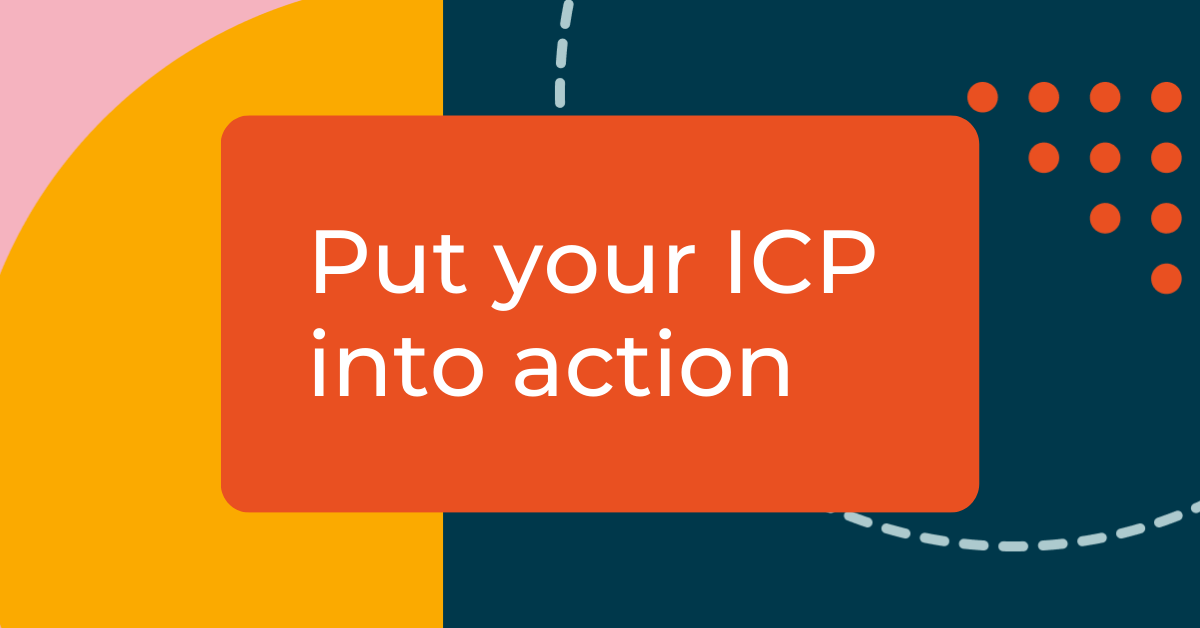Three ways to use your ideal customer profile as a score
Liz Gallagher
Jan 26, 2023 1:11:04 PM


Let’s talk about your Ideal Customer Profile, or ICP as those of us in the biz call it. Demand generation marketers use the ICP to know who to target, outbound sellers use it to determine who they email and call. At its basest level, your ICP is the audience you aim to sell your product or service to.
Your ICP is your sales targeting blueprint. It’s who uses and buys your product, and who needs your product, dialed in by firmographic data (company size, geography, revenue, industry). Building a good ICP takes spelunking in your CRM and customer data.
ICPs are not a one-and-done venture. You need to consistently test and push on your hypothesis, narrowing down the pool you fish in. Top of funnel works best the more targeted and precise you can be. Drag fishing the entire ocean pulls up a lot of garbage that clogs your pipeline, wastes a lot of rep time, doesn’t convert, and throws off your overall revenue forecast. The more you dial in who needs and will buy your product, the smaller pipeline forecast overage you need to hit goal. Can we say goodbye 5x pipeline coverage, hello 2x pipeline coverage?
Most sales and marketing teams stop at this point. They have an ICP, they prospect against it, and every now and then they update and reset. And that’s fine, but they’re missing an opportunity to turn that ICP into a silver bullet for their company.
The next step beyond creating and targeting against your ICP is turning it into a trackable, measurable score. An ICP score is a measure of the relative quality of all of the accounts and contacts in your CRM. Used well, it directs the team to spend time with the right people on the right deals. Simply put, every action is scored against the ICP, which tells you if you are focusing on the set ICP and whether that ICP is actually delivering for you.
Scoring involves determining the desirable and undesirable possibilities for each attribute of the ICP, then assigning weights to each attribute. For example, if retail is a desirable industry, it will get a high weight. If hospitality is undesirable, its weight will be low. The weights are then totaled and a score is assigned based on a range of possible totals.
Most ICP definitions evolve over time, so adjust your weights and add new attributes as needed. Account and contact level scoring are applied separately but the score makeup looks very similar. Contact ICP score will likely add job title, for example, directly on top of the account attributes.
1 - As an input to pipeline health: with ICP scoring, you’ve unlocked a powerful way to monitor pipeline health at a glance. Set a report that shows the percentage of high scores in your pipeline. The same can be done for ad campaigns to illustrate how much of the audience is on target.
Going deeper, a more robust ICP dashboard should break out the attributes that are most important to your business to show the makeup of your pipeline by each attribute (what percentage is in your priority industry, for example). Wherever ICP scoring is used, it should be accompanied by a score explanation—details about the attributes that determined the score—so you can easily double click when you need to.
An ICP score dashboard illustrates pipeline health
2 - To inform priorities: Taken alongside engagement with marketing and sales activities, ICP scoring is a useful input into account prioritization, particularly for prospecting. The engagement data surfaces conversion readiness. The more engaged a prospect is, the more ready to buy they are.
Ranking by conversion readiness alongside ICP score gives your team a prioritized, data-backed list of the most likely wins to work through and a very warm segment of leads for marketing. No matter how engaged a contact is, if they work for a company that will never buy your product, they go to the bottom of the list. Some companies consider ICP score as part of their B2B lead scoring for this reason
3 - To diagnose problems: ICP scores are a very useful dimension to slice metrics by when something is amiss. Consider a BDR who is struggling to get results despite a high activity level. Their manager should be empowered to easily drill down into the reasons why results are lacking. One angle they’ll want to explore is ICP score. Perhaps the BDR has somehow gotten off track in their understanding of what constitutes an ideal customer.
Similarly, when a top of funnel metric turns down, ICP score is a big piece of the puzzle that can inform what’s gone awry. It speaks directly to whether the team is working with the right people and the right companies, adding important context to the story of team activities and results.
When you turn your ICP into a score, you give yourself multiple competitive advantages. Most importantly, the ability to challenge assumptions backed by data. What if your highly scored leads fail to convert? You’re getting interest, but they may not be the economic buyer.
Try applying the ICP score to existing customers – you may be surprised what you find. What if a large portion of renewing customers score low? Clearly, they’re getting value from your product. Dig deeper into why they are renewing and test changing the ICP.
Doing the work to operationalize your ICP has far-reaching implications. The clarity that comes from using it as a lens across sales activities, marketing campaigns, and even NRR.
Falkon scores prospecting activity against ICP. Learn more about our sales productivity tool >